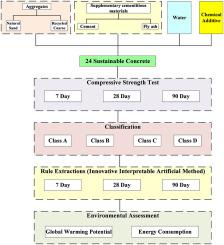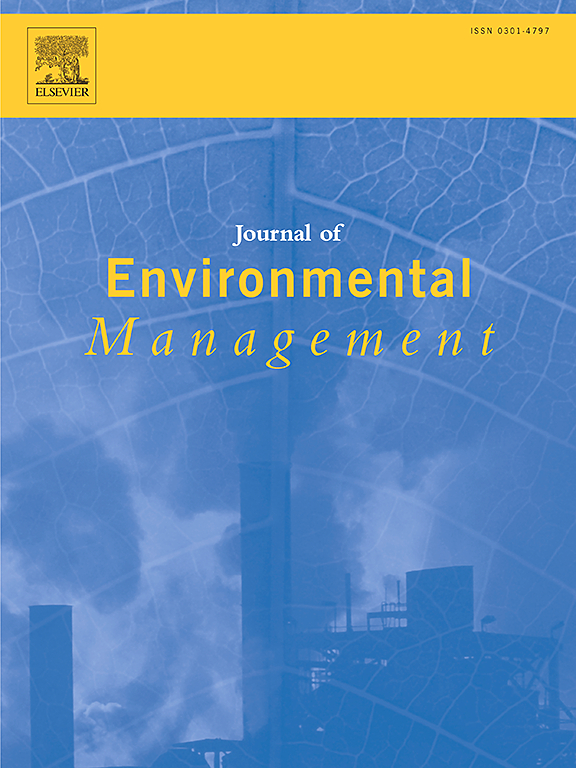利用基于创新可解释人工智能方法的多目标优化,对可持续混凝土的机械性能和环境影响进行建模和评估。
IF 8
2区 环境科学与生态学
Q1 ENVIRONMENTAL SCIENCES
引用次数: 0
摘要
本研究的重点是利用基于人工智能的可解释自动规则提取技术,对可持续混凝土的机械和环境特性进行建模,对废弃材料进行管理,并展望未来。为此,我们制作了 24 个含有粉煤灰和再生骨料的可持续混凝土系列。对这些试样进行了 7 天、28 天和 90 天的抗压强度测试,并对其力学性能进行了评估。混凝土等级(A 级、B 级、C 级、D 级)是根据每个试验日获得的抗压强度值确定的。使用独特的可解释多目标规则提取模型对每个混凝土等级的结果进行分析,并确定所用材料的范围值。所应用的多目标规则提取方法是首次在文献中使用,其最重要的新颖之处在于,与其他黑盒人工智能方法不同,它还可以创建可持续的混凝土配方。通过自动规则提取找到所用材料的范围值后,进行了环境影响评估。在影响类别中,考虑了能源消耗和全球变暖潜势。规则 4 的能耗计算结果分别为 814.8-1467.1 兆焦耳,减少了约 44.5%。同样,规则 3 的全球升温潜能值分别为 187.0-267.3 kg m3,减少了约 30%。对研究的局限性和未来前景进行了广泛调查。强调了在可持续发展和循环经济目标范围内采用可解释/可解读人工智能方法的重要性,以开发在机械和环境性能方面可行的低碳排放社会基础设施和建筑。基于多目标优化的创新可解释人工智能方法首次用于可持续混凝土的力学和环境建模,可为文献和未来研究做出重大贡献。本文章由计算机程序翻译,如有差异,请以英文原文为准。

Modelling and evaluation of mechanical performance and environmental impacts of sustainable concretes using a multi-objective optimization based innovative interpretable artificial intelligence method
This study focuses on modelling sustainable concretes' mechanical and environmental properties with interpretable artificial intelligence-based automated rule extraction, management of waste materials, and meeting future prospects. In this context, 24 sustainable concrete series containing fly ash and recycled aggregates were produced. Compressive strength tests were performed on these specimens at 7, 28, and 90 days, and their mechanical properties were evaluated. Concrete classes (Class A, B, C, D) were determined using the compressive strength values obtained for each test day. The results of each concrete class were analyzed using a unique interpretable multi-objective rule extraction model, and the range values of the materials used were determined. The applied multi-objective rule extraction method is used for the first time in the literature, and its most important novelty is that, unlike other black-box artificial intelligence methods, it can also enable the creation of sustainable concrete recipes. After the range values of the materials used were found by automatic rule extraction, environmental impact assessments were performed. Among the impact categories, energy consumption and global warming potential were considered. The energy consumption results for Rule 4 were calculated as 814.8–1467.1 MJ, respectively, and a reduction of approximately 44.5% was observed. Similarly, global warming potentials for Rule 3 were obtained as 187.0–267.3 kg m3, respectively, with a reduction of about 30%. The limitations and future prospects of the study have been extensively investigated. The importance of adopting explainable/interpretable artificial intelligence-based approaches within the scope of sustainable development and circular economy goals to develop social infrastructure and buildings with low carbon emissions that are feasible in terms of mechanical and environmental properties is highlighted. Multi-Objective Optimization Based Innovative Interpretable Artificial Intelligence Method, used for the first time in mechanical and environmental modelling of sustainable concretes, can make significant contributions to the literature and future studies.
求助全文
通过发布文献求助,成功后即可免费获取论文全文。
去求助
来源期刊

Journal of Environmental Management
环境科学-环境科学
CiteScore
13.70
自引率
5.70%
发文量
2477
审稿时长
84 days
期刊介绍:
The Journal of Environmental Management is a journal for the publication of peer reviewed, original research for all aspects of management and the managed use of the environment, both natural and man-made.Critical review articles are also welcome; submission of these is strongly encouraged.
 求助内容:
求助内容: 应助结果提醒方式:
应助结果提醒方式:


